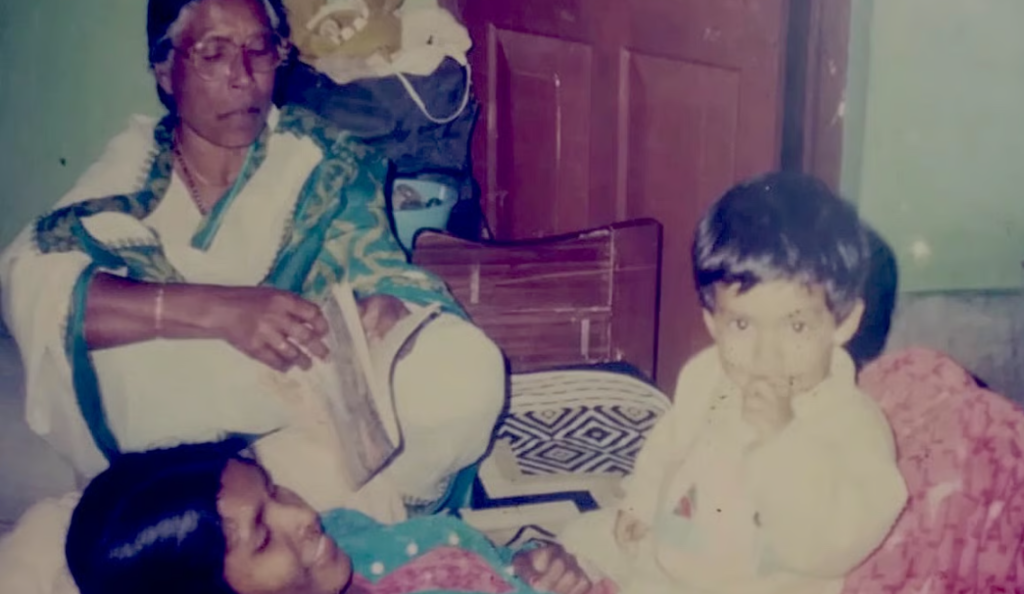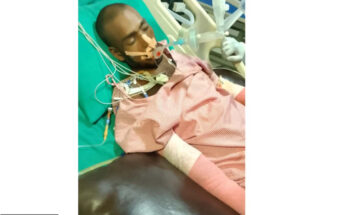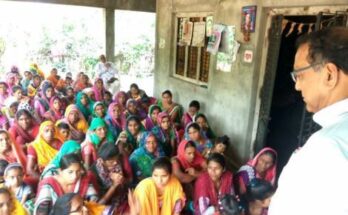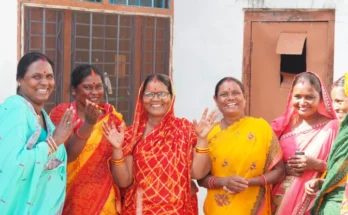
MY GRANDMOTHER died over a decade ago. Every now and then, I am reminded of the tales she used to tell me when I was a child. Many were from the Mahabharata, the Hindu epic that she taught herself to read. She kept her copy in a cloth case, striped yellow, red and blue, on top of an almirah in our railway officer’s housing in Chittagong (now called Chattogram), in south-eastern Bangladesh. It was her belief that one should keep the Mahabharata at the highest place in the room, in recognition of its sanctity.
My “uneducated” but self-taught grandmother taught me how to read the Mahabharata – and the Bhagavad Gita, the philosophical treatise contained within it – as well as the other famous Hindu epic, the Ramayana. To this day, I remember many shlokas, or verses, from these sacred texts, simply because she had me recite them over and over.
My grandmother raised my father, who became a chief engineer of Bangladesh Railway. She used to say that I was destined for great things, partly because I was good at reciting holy texts but mostly because I was the only boy in my family and deemed the “light of the clan.” I was never sure what she meant, and I am more unsure now if I will ever live up to her expectations. She always thought I would be a great religious scholar. I have become a scholar, but a scholar of politics, not religion.. Still, she inspired me to learn my religion.
Inevitably, the contradiction of our caste came up. My family belongs to the Namasudras, a Dalit community, deemed lower than the lowest caste in the Hindu order. The Namasudras were once known by another name: Chandals – a word that stung like a slap when uttered in the wrong tone, in the wrong place. Chandals were the people who cremated the dead. They lived on the margins, geographically, socially and spiritually. In Bengal’s villages, they were forced to live outside the perimeters of the main settlement, near the cremation grounds. They performed the last rites of others but were denied their own dignity. They handled the bodies of the dead but were not allowed to sit among the living. They were the polluters, the untouchables, the remainder of a cruel arithmetic known as varnashrama – the Hindu social and spiritual hierarchy. Religious diktat bound them to this menial duty and denied them education.
The holy Hindu texts were supposed to be read and studied by Brahmins only. I asked my grandmother: How could I ever be a great scholar when I was not even supposed to read these texts? Was I not breaking the divine code? My caste dictated that I serve the people of the dominant castes, but instead I was studying. Where the texts decreed“chhatranang addhayang tapah” – It is the meditation of the student to study – I am sure they meant only Brahmin students, not Namasudra ones.
In the Mahabharata, the renowned teacher Dronacharya manipulates Eklavya, a tribal prince, into cutting off his thumb. He does this to prevent Eklavya from competing with, and possibly beating, the dominant-caste Kshatriya hero Arjun at archery. Eklavya’s status in the caste order, as a tribal or Adivasi, would have been close to that of the Namasudras today. Would I have to cut off my thumb too in my pursuit of knowledge?
In response to my confusion, my grandmother told me a fascinating tale. She said that our family was not really Namasudra. We used to be Brahmins, she claimed, but proud and rebellious ones. Some of our ancestors rebelled against the misrule of Laxman Sen, a 12th-century king of the Sena dynasty in Bengal. As a result, they were driven out towards the Sundarban, the mangrove forests of the Ganga delta. While travelling through the Sundarban to get to Khulna, in what is now south-western Bangladesh, their paitas – the white threads that Brahmins wear around their torsos – were torn away by thorny plants. And so they were shunned from Brahmin society.
My grandmother probably had this tale handed down to her and she believed deeply in its veracity. This is the first inheritance I got from her: a myth of once being Brahmin that empowered me to venture down the road of education. As I continued down that road, I discovered how my family had upended their social destinies by creating their own stories and myths – and, in doing so, created better lives for their children.
WHEN I WAS YOUNG and my caste-Hindu friends asked me what my caste was, I would say I was Brahmin. I had not yet learnt the power of accepting my Dalit background – which, in Hindu belief, renders me casteless, outside the pale of caste status – or to take pride in my Namasudra identity. I worried that the caste-Hindu boys in my Bangla-medium boys’ school in Chattogram would refuse to be my friends if they knew my true identity. As I grew older, I started admitting that I was actually Namasudra. As I expected, many of my caste-Hindu friends became distant. I became closer with my Muslim friends, some of whom tried to persuade me to accept Islam. Some even tried to feed me beef by tricking me, but I excused them because they too were kids and did not know any better. (My family adheres to the Hindu injunction against eating beef, as do many Dalit families. Other Dalits across Southasia, however, have long consumed beef, and continue to do so today whether covertly or in proud defiance.)
In my adolescence, I used to spend lazy afternoons in the large drawing room of our three-bedroom apartment, which was lavish compared to many homes in Bangladesh. Our household help, for instance, lived in a slum at the foot of the hill on which we lived. I did not get on well with other boys of my age in the neighbourhood. Almost all of them were the children of railway officers, and there was a clear hierarchy among the boys based on how high-ranking and rich their fathers were. I ranked low, not just because my family was less affluent and my father relatively low-ranked, but also because we were Hindu, a small and sometimes unwelcome minority in Bangladesh. There weren’t many other Hindu boys around, so I cannot say for certain if it was mainly my personality, social status or religion that singled me out. But I certainly felt a sense of alienation, a sort of othering. So I spent my afternoons away from the playground and in front of a giant bookshelf in that drawing room.
It did not take me long to finish most of the books on the shelf. I read books on cooking, on the share market and even on arthritis. But there was a series of books that I never touched. One of them was a paperback in a brown cover bearing a black-and-white photo of a lawyer – which to me, at that age, seemed like the most boring thing one could be. The book’s spine, the only part of it that I would read, had the word “Babasaheb” – something I found quirky at the time. That was my first introduction to B R Ambedkar, the anti-caste icon and emancipator of Dalits. I read his aura before reading him.
My second encounter with Ambedkar was at Columbia University in New York City, where I spent a semester on an exchange programme from Howard University in Washington DC. I stayed in a dormitory right next to the Columbia Law School library, where a statue of Ambedkar commemorates his time studying there. I would later also study at the London School of Economics, which also once hosted Ambedkar as a student and now has a statue of him.
I started reading Ambedkar while at Columbia, and remembered why I never read him as a child. My father had told me not to. He had bought books by Ambedkar and read some of them at least. He read enough to feel angered by caste discrimination, which Ambedkar assails, but he thought these books would cause unnecessary anger at things that we could never change. He worried that such anger could only lead to conversion to another religion, as it did for Ambedkar himself.
TO MY FATHER, like many other Hindus, conversion is the highest moral crime. Our clan had resisted conversion even though it might have materially and objectively improved our standing. Conversion, in their view, would steal our identity and lead to us being shunned by relatives and our community. I was always warned to resist conversion, no matter how lucrative the rewards seemed.
When I recall this exchange with my father, I understand why some Namasudras in Bangladesh never converted to Islam – or to Buddhism or Christianity – despite the promises of worldly and otherworldly benefits. To some Namasudras, conversion is worse than oppression. This, I believe, helped the community persevere by keeping intact its religious and caste identities, which bound it together through the collective experience of oppression by other castes and other religious groups.
My father always argued that Namasudras were above the Chandal caste in the social hierarchy as we were historically peasants and not undertakers. This offered some validation within the oppressive structures of caste itself. Among the low, there were the lowest – and we were higher than them. It is hard to ascertain the delineation between Namasudras and Chandals. Our family maintains that we are completely separate, but I have a suspicion that some Chandals may have moved to unclaimed farmlands and started working as peasants and called themselves Namasudra. But when we recite the names of the last seven generations of our ancestors every Diwali, my father reminds us that all of them were landholders or peasants and some were even tradespeople and jewellers, but never undertakers. At any rate, the Namasudra community in the area my father comes from are mostly peasants and deeply tied to their lands.
Social cohesion plays out differently in Namasudra communities across Bangladesh. One of the reasons for the failure of the movement to prevent the construction of a power plant at Rampal, in the country’s south-west, was the lack of broad solidarity in the local society, or samaj, which includes minority Hindus. The result was locals’ easy expulsion from their land. However, in parts of Khulna and Bagerhat, also in south-western Bangladesh and where I have roots, the Namasudras are mostly from agrarian societies with strong bonds to their lands and a strong sense of samaj. To them, expulsion from the samajis close to death. This is why when I asked one of my uncles, who is close to my age, what it would take for him to convert to a different religion, he answered, “I would rather die first.”
Ambedkar’s critiques of Hinduism’s caste-based discrimination have not reached many Namasudras. Their connection to the Hindu religion is such that they could not imagine leaving it behind. I have heard stories from relatives who still live in rural Bangladesh about how, in the past, anyone who left the religion was excommunicated, and anyone who interacted with them was also expelled. Namasudras safeguarded their “purity” by denigrating converts from the community as “touch-Muslims”, “smoke-touch Muslims” or “shadow-touch Muslims” – labels used for those thought to have become Muslims by touching a Muslim person or even just a Muslim’s smoke or shadow. The Namasudras adopted these communally divisive strategies because they considered conversion to be worse than the caste oppression they faced. They would rather accept the denial of education and other deprivations rooted in caste belief – not travelling abroad, for instance, in the belief that this would cause loss of caste status – than risk becoming apostates.
THE WORD “Namasudra” did not mean much to me when I was younger. It was just something my father would mention when he reminded me to stay quiet about our caste. My mother never spoke of it, but carried it quietly in her cautious glances at temple doors and religious rituals. We carried our caste in our bodies and minds. It seemed as naturally a part of us as breathing: something innate and automatic even before we had a name for it. Caste was something I felt in the way my classmates looked at me when they learnt I could never be their equal, let alone their superior, even though I outranked them in exams. What I felt was not shame but dismissal – an unspoken understanding that we were not quite the same. It was only much later, through books and conversations, memories and myths, that I began piecing together the strange puzzle of Namasudra identity. And the more I learnt, the more I felt in awe of resilience.
One story of caste discrimination that I pieced together from readings and retellings has stayed with me over the years. In 1873, in the Faridpur district, in present-day Bangladesh, a man named Choron Sapah, a prosperous Namasudra, organised a community feast. He invited people from all castes as a gesture of unity. But unity is a difficult word when you have been taught about caste and ritual purity all your life. The Brahmins and Kayasthas refused to attend, citing caste pollution. That refusal lit a flame in the hearts of the Namasudras. Something about the rejection revealed to them the shape of their own bondage – and, more importantly, the possibility of liberation.
This flame would later be stoked into a fire of resistance by the social reformer Harichand Thakur, a figure whose name is whispered with reverence in many Namasudra homes, mine included. Thakur founded the Matua movement in late 19th-century Bengal. It later became not only a separate religious sect but a lifeline for many Namasudras. Matua Dharma was radical not because it promised salvation, but because it promised dignity. Thakur, and later his son Guruchand, preached a faith rooted in equality, education and self-respect. They built schools and preached cleanliness – not ritual cleanliness, but cleanliness of the soul. They told their followers: You are not less, you never were. In a land where the touch of a Namasudra was once considered defilement, Thakur’s words became a balm and a healing myth. And, like all good myths, it spread.
In 1911, the Namasudras were categorised as a “Depressed Class” in the British colonial administration’s census of India. It was a backhanded recognition, but it was also a kind of legitimisation – a line in a ledger that meant Namasudras were no longer invisible. With this came new political stirrings. The most notable of these came from a man I have always found both tragic and brave: Jogendranath Mandal.
Mandal was one of the few Namasudras to rise to national political prominence during the late colonial period. He was not content with just fighting for scraps in the Indian National Congress, where caste hierarchies replicated themselves behind the curtain of nationalist fervour. So he allied with Muhammad Ali Jinnah’s Muslim League, a move many consider to be a betrayal of the Hindu – and especially the dominant- caste Hindu – community. Mandal believed Dalits would find more space to breathe in the Pakistan Jinnah and his party were promising, that there they would be more than the lowest class in a society obsessed with purity. History proved him wrong. After Partition, Mandal would flee East Pakistan in despair, his dream undone. But when I remember gravitating towards my Muslim friends in childhood after being rejected by my caste-Hindu peers, I understand why he tried.
MY FATHER MARRIED into another Namasudra family. It was an arranged marriage and exogamy was not the usual practice. He wanted his children to be brought up by someone educated, who came from a background of education, and my mother was a great choice. She had been an A+ student and often stood first in her class – something she never let my sisters and me forget during our school days. Her family had been educated for generations even though they were Namasudras. In fact, my maternal great grandfather, Rishikesh Roy, was a “Namasudra Brahmin”.
Rishikesh grew up in Khulna, where, according to my grandmother, there were not very many schools during his childhood because the government did not care about the education of Dalits and Muslims, who formed the majority of the local population. He had to travel to Calcutta for his schooling, and while money was not an impediment, his caste was. The school he liked only enrolled Brahmin boys. So Rishikesh reached out to his Brahmin playmates and explained his predicament. They gave him a paita, taught him the Vedic chant of the Gayatri Mantraand instructed him in how to behave like a Brahmin. He got away with it and became the first Namasudra Brahmin in my family. He also had some help from the surname Roy, which I carry as well.
The Roy surname acts like a camouflage for my family. Sometime in the last two centuries, some clever ancestor of mine changed our family name to Roy from Mandal, which is a marker of Namasudra identity. When someone asks anyone in my family for our last name to infer our caste, we simply give out the royal last name of Roy. In many land titles, we are still listed as “Mandal”. Rishikesh bore the Roy name as he made his way through school, became a school teacher and taught for many years.
My father’s sister was married to a professor of philosophy who has the last name Mandal, but she continued to use her paternal last name – Roy. She fought caste and gender discrimination all her life and became a primary-school headteacher against all odds. She was also a Namasudra doing work long reserved for Brahmin men.
My father became yet another Namasudra Brahmin. He left his village to attend college, studied engineering and then travelled to Germany for further training. Like many others, he broke the Hindu code of never crossing the sea, which was supposed to lead to the loss of caste status. He defied religious custom for the sake of education, and because he did so, I could seek education in the United States and in the United Kingdom. My father reached for the Brahmins’ monopoly on knowledge and squeezed through the caste ceiling so that I would not even have to think about it. His daring carried me into a social setting where caste did not limit my life as it had limited his.
I am also a Namasudra Brahmin. I was a student leader in my school. During morning assemblies, I used to read the pledge of allegiance to the state of Bangladesh. After a recitation from the Quran, I used to lead a recitation of the Gita. Dozens of Brahmin students would stand there in the scorching sun and repeat after me, “Yada yada hi…” In later years, I led many public prayer events, including ones during protests. I remember once, when we were protesting against the rampant killings along the India–Bangladesh border, I recited the Gita in front of the famous Raju memorial sculpture at the University of Dhaka. Nobody ever asked me if I was a Brahmin or not. If they did, I would not lie.
WHEN BANGLADESH WAS BORN, in 1971, the country spoke the language of liberation, but not always of equality. Many Namasudras migrated to India, driven by fear, by religious violence, and by the same social wounds that had plagued them under both British and Pakistani rule. Those who stayed did so either because they were rooted in the land, or because they had nowhere else to go. In independent Bangladesh, too, caste did not disappear. It just became harder to name.
I grew up surrounded by people who would not say the word “Dalit”, as if not naming something would make it less true. My uncles and aunts would tell stories of Muslims who had converted from Namasudra families but were still referred to by old caste names, or treated differently, subtly but persistently. My relatives spoke in hushed tones about those who had “mixed” – “mleccha” – or those who had “crossed the line”, as if the boundary was not a social construction but a sacred law.
And yet, in that same community, I saw immense pride. I saw people like my mother, who topped her class. I saw elders who still lit lamps during Matua rituals. I saw men and women who may never read Ambedkar but whose lives were Ambedkarite in their striving for dignity, knowledge and equality. They did not need jargon. They knew what it means to be told you are less, and to rise anyway.
My great-grandfather Rishikesh Roy did not have the vocabulary of caste abolition or subaltern resistance. But he understood survival. He understood that wearing a paita could open doors. He wore it not because he believed in the Brahminical order, but because he wanted to breach its gates. That act, which might seem deceitful to some, feels to me like a quiet revolution. A rupture in the great chain of oppression. It is the same rupture that allowed my father to cross the sea for training in Germany. The same rupture that brought me to Columbia and then to LSE and then to Oxford. The same rupture that allows me now to write these words unapologetically, truthfully, with the kind of myth that reshapes reality.
To be Namasudra is to live with contradiction, to carry pain and pride in the same breath. But we are not a defeated people. We are a people who make myths not to escape the world but to transform it. We are not waiting to be saved. We are finding ways to save ourselves, one verse, one lie, one truth at a time.
Above all, the story of the Namasudra Brahmin is a story of the power of myth. One way that the marginalised fight their way out is through stories. We build stories about our clans, our ancestors, our religious identities, our languages, our genders, our classes, our educational and other institutions. These stories help us understand the world and our place in it.
The apparent lie my grandmother told me gave me the license to study and get to where I am today. The myths of the marginalised must be built against the myths of the oppressors, to counteract unjust social and religious practices. Only by rebuilding our storied world can we find a way to advance our real freedoms.
Source: Himalmag



